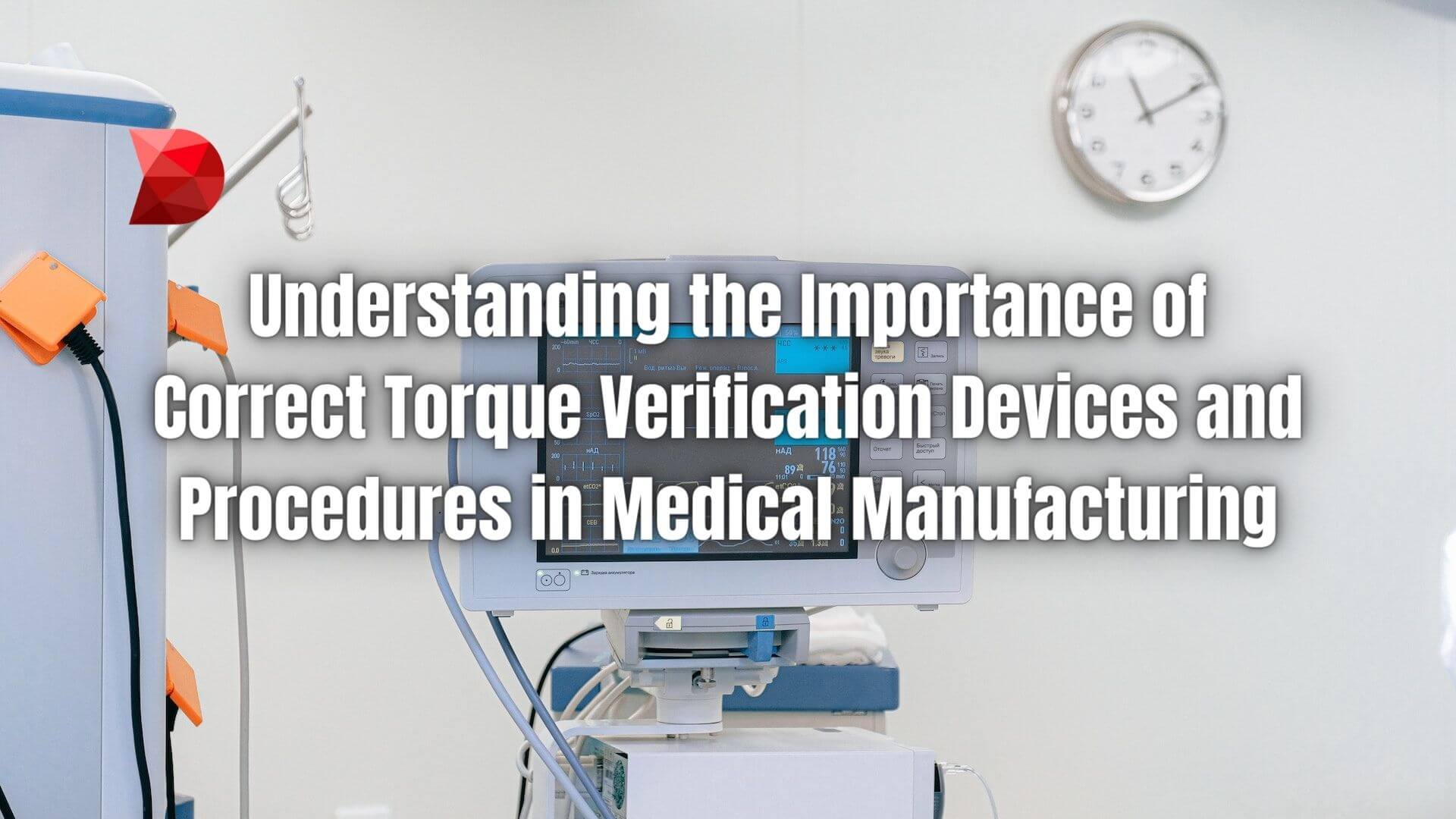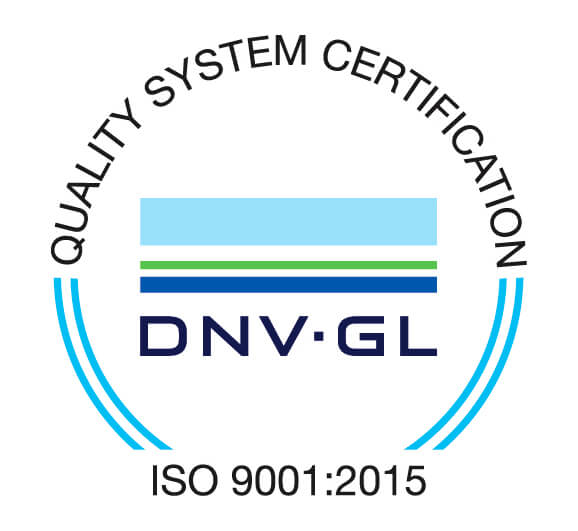Ensuring the accurate application of torque in medical devices is paramount for manufacturers in the healthcare sector. Maintaining compliance with steep regulations set by the United States Food and Drug Administration (FDA) requires an in-depth understanding of these rules and the tools and procedures used to meet them.
Central to this is torque verification, a pivotal process in medical manufacturing that guarantees devices operate as intended, maintaining patient safety and device efficacy. This guide discusses critical torque verification devices and the procedures essential for their application in medical manufacturing.
Table of Contents
ToggleThe Role of Torque in Medical Manufacturing
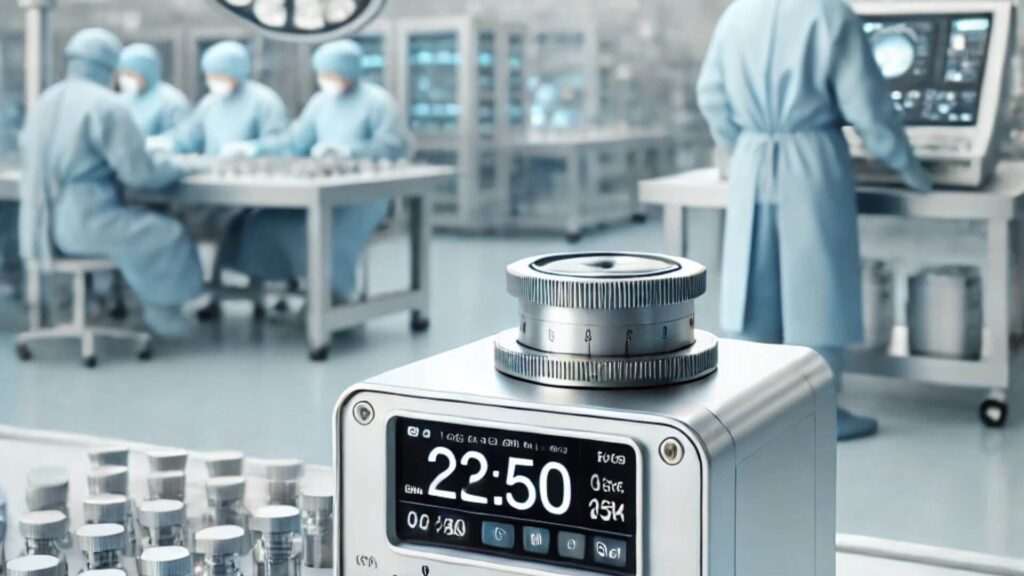
Torque plays a multifaceted role in the manufacturing of medical devices, influencing both the production process and the final product’s performance. It is a critical parameter that manufacturers need to control and verify throughout the production process. Below are key roles that torque and torque verification fulfill in the medical manufacturing industry:
Ensuring Reliable Assembly
Torque is instrumental in ensuring the reliable assembly of medical devices. Proper torque application guarantees secure and accurate connections between different components, resulting in a dependable final product. In this context, Torque verification ensures that the assembly process meets the required specifications.
Maintaining Product Integrity
The application of correct torque maintains the integrity of the medical device. Over-torquing can lead to premature wear and potential failure of the device, while under-torquing can result in loose connections. Regular torque verification procedures help identify and correct these issues, preserving product integrity.
Compliance with Regulatory Standards
Compliance with FDA regulations is a necessary part of medical manufacturing. As torque directly impacts a device’s functionality, accurate application and verification are paramount in meeting these standards. Regular torque verification ensures ongoing compliance with these regulatory requirements.
Ensuring Patient Safety
Lastly, the correct application of torque is vital for patient safety. Any malfunction or failure of a medical device due to improper torque can have serious implications. Thus, torque verification is a critical procedure to ensure the safety and well-being of patients relying on these devices.
Standards and Regulations for Torque Application in Medical Manufacturing
Medical manufacturing in the United States is managed under a regulatory framework that sets stringent standards for torque application. Adherence to these standards is vital to ensure the safety and efficacy of medical devices.
FDA Regulations
The FDA outlines specific standards for the manufacturing of medical devices, including guidelines for torque application. These directives establish the parameters within which manufacturers must operate.
- Establishment Registration: Manufacturers must register their establishments annually, and this registration includes a detailed presentation of their manufacturing process, including torque application and verification procedures.
- Good Manufacturing Practices (GMP): Among other things, GMP outlines the need for adequate controls in the manufacturing process, including torque application. Manufacturers are required to show that they have procedures in place to verify the correct application of torque.
- Pre-market Approval (PMA): This is the FDA’s scientific and regulatory review process to evaluate the safety and effectiveness of Class III medical devices. This includes a rigorous examination of the torque application process.
ISO Standards
In addition to FDA guidelines, international standards like those from the International Organization for Standardization (ISO) also provide relevant directives for torque application in medical manufacturing.
- ISO 13485: This standard outlines the requirements for a comprehensive management system to design and manufacture medical devices. It includes specific recommendations for the control of production processes, which include the application of torque.
- ISO 6789: This is a specific standard for hand torque tools, which are often used in medical device manufacturing. This standard outlines the methods for calibrating and verifying these tools, ensuring accurate and consistent torque application.
Other Relevant Standards and Regulations
Some other industry-specific regulations and standards may apply to certain types of medical devices or manufacturing processes. Manufacturers need to be aware of these and ensure they remain in compliance.
Adherence to these rigorous standards and regulations underlines the importance of using the correct torque verification devices and following the proper procedures in medical manufacturing. It helps ensure not only the safety and effectiveness of the devices but also the manufacturer’s regulatory compliance.
Torque Verification Devices in Medical Manufacturing
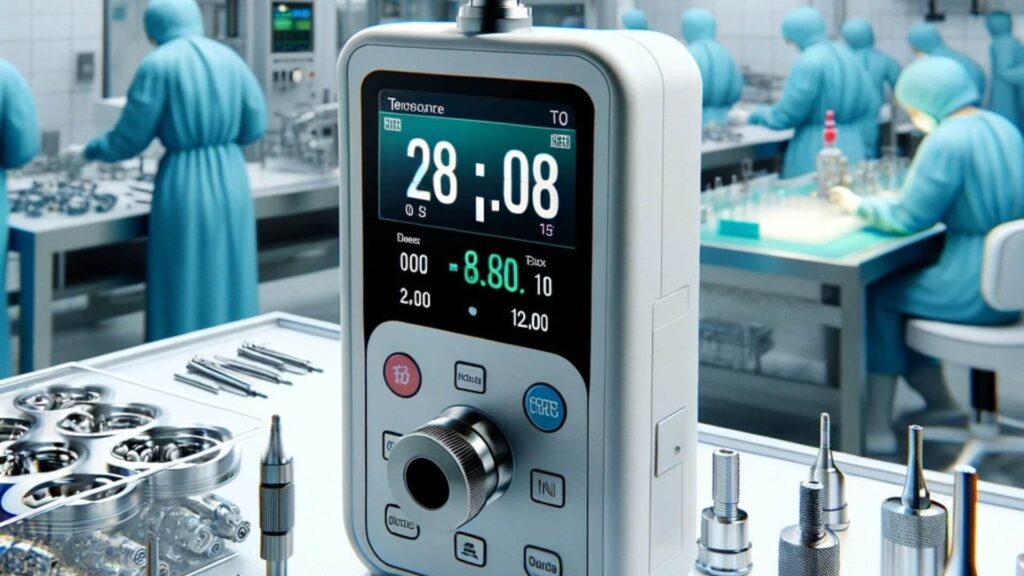
Torque verification in medical device manufacturing relies heavily on specialized devices designed to provide accurate and consistent torque application. These tools, often used in conjunction with torque verification procedures, ensure the quality and reliability of the finished products. In this section, we will explore some of these essential devices.
Break-over Wrenches
Break-over wrenches are precision torque tools commonly used in medical device manufacturing. They function by applying a specific amount of torque to a fastener and then ‘breaking over’ when the pre-set torque is achieved, reducing the risk of over-torquing. This tool is beneficial in the manufacturing of medical devices as it assures precise torque control, contributing to the quality and safety of the final product.
Cam-over Wrenches
Cam-over wrenches provide an additional layer of torque control, eliminating the possibility of over-torquing. Once the pre-set torque value is reached, the tool’s unique mechanism slips or ‘cams over,’ preventing additional torque from being applied. This precise control makes cam-over wrenches an ideal choice for medical device manufacturing, where adhering to exact torque specifications is vital.
DC Control Electric Screwdrivers
DC control electric screwdrivers are advanced torque tools that provide exceptional control and data output capabilities. They offer adjustable torque settings and real-time monitoring, making them suitable for high-precision and traceability applications. These tools play a crucial role in the medical device manufacturing industry, where accurate data and quality control are paramount.
Clean Room Screwdrivers
Medical device manufacturing often takes place in cleanrooms and controlled environments with low levels of pollutants. Clean room screwdrivers are designed to operate in these conditions without compromising the environment. They are often built from materials that limit particle generation and are corrosion-resistant. These attributes make them an essential tool in the assembly of medical devices, ensuring both the product’s quality and the cleanliness of the manufacturing setting.
Classifications of Medical Devices
Medical devices, as defined by the FDA, are classified into three primary categories – Class I, Class II, and Class III. This classification is based on the device’s intended use, the indications for use, and the potential risks they pose to the patient or user. The higher the risk associated with the device, the stricter the regulatory requirements for its production and usage.
Class I Medical Devices
Class I medical devices are those with the least risk to the patient and/or user. They are typically simple in design, have a history of safe use, and pose minimal potential for harm to the user. Bandages, examining gloves, and portable surgical equipment are a few examples of Class I devices. Key characteristics of Class I devices include:
- Least amount of regulatory control: These devices often do not require pre-market approval (PMA) or clearance.
- General Controls: Class I devices are subject to general controls, including establishment registration, good manufacturing practices, proper branding and labeling, and mandatory reporting of adverse events.
Class II Medical Devices
Class II devices are more complex than Class I and carry a moderate to high risk to the patient or user. These might include infusion pumps, powered wheelchairs, or pregnancy test kits. Key characteristics of Class II devices include:
- Special Controls: In addition to the general controls, these devices are subject to special controls, which may include special labeling requirements, mandatory performance standards, and post-market surveillance.
- Pre-market Notification 510(k): Most Class II devices require FDA clearance through the 510(k) pre-market notification process.
Class III Medical Devices
Class III is the most stringent medical device classification. These devices sustain or support life, are implanted, or present a potentially unreasonable risk of illness or injury. Examples include implantable pacemakers, HIV diagnostic tests, or automated external defibrillators (AEDs). Key characteristics of Class III devices include:
- Pre-market Approval (PMA): Class III devices typically require FDA approval through the PMA process, which is more rigorous than the 510(k) process.
- Scientific Review: The FDA thoroughly reviews clinical data to ensure the device’s safety and effectiveness before it can be marketed to the public.
The correct understanding of these classifications is fundamental to maintaining the required standards for torque application in medical device manufacturing.
Establishing Compliant Quality Assurance Systems
Establishing a robust and compliant quality assurance system is a key requirement in the medical manufacturing industry. This system ensures that all manufactured medical devices meet the necessary safety and efficiency standards set by the FDA. Here are the critical components of a compliant quality assurance system in medical device manufacturing:
Quality Planning
Quality planning involves setting goals and objectives and identifying the necessary processes and resources to achieve them. This is the stage where companies establish their quality policies and procedures, define their quality control methods, and identify the quality standards they aim to achieve.
Quality Control
Quality control focuses on product-oriented activities. It involves routine inspection and testing of medical devices to ensure they meet the defined quality standards. Regarding torque verification, quality control could involve:
- Routine testing of torque tools.
- Checking and calibrating their measurements.
- Verifying that the applied torque meets the required specifications.
Quality Assurance
While quality control focuses on the product, quality assurance focuses on the process. It involves regularly reviewing and auditing the manufacturing processes to ensure they comply with quality standards. Quality assurance could involve:
- Conducting internal audits.
- Providing employee training.
- Managing documentation.
- Regularly evaluating the effectiveness of the quality system.
Quality Improvement
Continuous improvement is a crucial element of a quality assurance system. It involves continually monitoring, measuring, and improving the quality system’s effectiveness. In terms of torque verification, quality improvement could involve:
- Regularly updating and refining torque application procedures.
- Adopting newer and more accurate torque verification devices.
- Implementing feedback from audits and inspections to improve the quality system.
By implementing these essential components, companies can establish a successful quality assurance system that ensures their medical devices meet the necessary safety and efficiency standards.
Torque Control in Medical Manufacturing
Controlling, monitoring, and verifying torque in medical manufacturing is critical to ensure that products meet the necessary safety and performance standards. In the manufacturing of medical devices, where precision and reliability are paramount, incorrect torque could lead to device failure, potentially posing significant risks to patient safety. For torque verification in medical manufacturing, a variety of instruments and techniques are available.
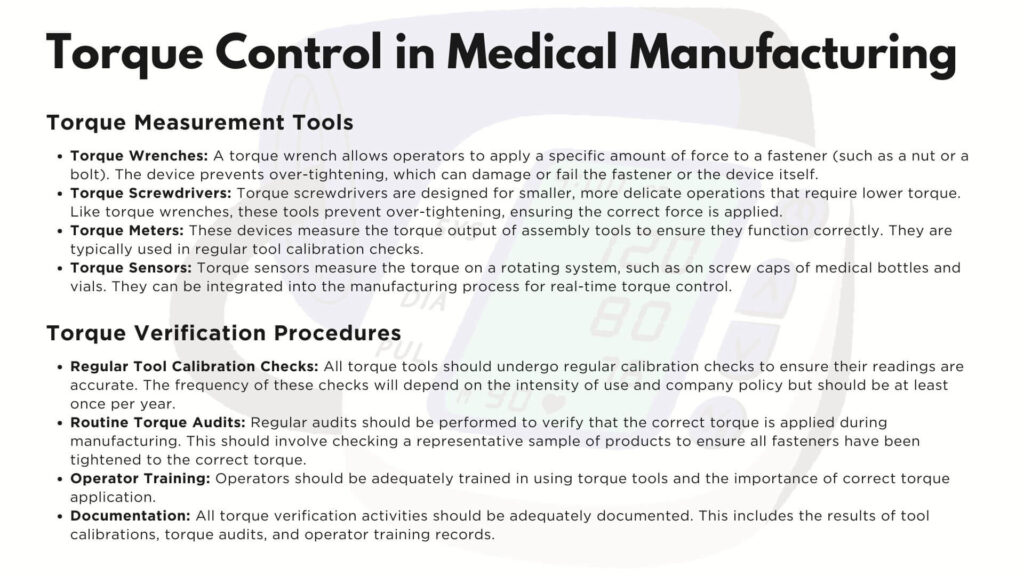
Torque Measurement Tools
There are various torque measuring tools, each designed to serve different purposes in the manufacturing process. Some commonly used tools include:
- Torque Wrenches: A torque wrench allows operators to apply a specific amount of force to a fastener (such as a nut or a bolt). The device prevents over-tightening, which can damage or fail the fastener or the device itself.
- Torque Screwdrivers: Torque screwdrivers are designed for smaller, more delicate operations that require lower torque. Like torque wrenches, these tools prevent over-tightening, ensuring the correct force is applied.
- Torque Meters: These devices measure the torque output of assembly tools to ensure they function correctly. They are typically used in regular tool calibration checks.
- Torque Sensors: Torque sensors measure the torque on a rotating system, such as on screw caps of medical bottles and vials. They can be integrated into the manufacturing process for real-time torque control.
Torque Verification Procedures
Torque verification procedures are designed to ensure that torque tools function correctly, deliver the correct amount of force, and maintain their calibration over time. Typical procedures involve:
- Regular Tool Calibration Checks: All torque tools should undergo regular calibration checks to ensure their readings are accurate. The frequency of these checks will depend on the intensity of use and company policy but should be at least once per year.
- Routine Torque Audits: Regular audits should be performed to verify that the correct torque is applied during manufacturing. This should involve checking a representative sample of products to ensure all fasteners have been tightened to the correct torque.
- Operator Training: Operators should be adequately trained in using torque tools and the importance of correct torque application.
- Documentation: All torque verification activities should be adequately documented. This includes the results of tool calibrations, torque audits, and operator training records.
By implementing proper torque control measures, medical device manufacturers can ensure their products meet the highest quality and safety standards in compliance with FDA regulations.
Measure Torque with DATAMYTE
DATAMYTE, a recognized industry leader in providing robust data collection and low-code quality management solutions, offers a range of torque products designed to enhance accuracy and efficiency in various manufacturing environments.
LightStar™ Torque Wrench
This precise torque-measuring instrument is designed to eliminate false readings that are difficult to detect. The LightStar™ Torque Wrench series technology sensor ensures that the operator can pull at any point on the wrench and will receive an accurate measurement.
DataMyte Torque Solution
This solution provides real-time reporting and torque data collection to improve and monitor torque continuously. It’s a comprehensive system for managing all aspects of torque control, from data collection to analysis and reporting.
New Generation of Digital Torque Wrenches
DATAMYTE has introduced a new generation of their LightStar™ Carbon Fiber Torque Wrench. These digital torque wrenches offer improved performance and accuracy, making them ideal for demanding industrial applications.
These products are part of DATAMYTE’s commitment to providing quality management solutions that enhance actionable results based on collected production data. They are designed to ensure consistent, reliable torque application, improving the quality and reliability of assembled products. Book a demo with us now to see how we can help you achieve your torque accuracy goals.
Conclusion
Implementing accurate torque verification devices and adhering to the best procedures are essential in medical manufacturing. The stakes are high, and the margin for error is minimal. The rigorous FDA regulations underscore the need for robust and reliable torque control measures, and several torque verification devices are designed to meet these stringent demands.
With regular calibration checks, routine audits, and proper operator training, we can ensure the delivery of safe, high-quality medical devices that comply with all regulatory standards. Let’s strive together for precision, safety, and reliability in every product we create.
It’s time to take the next step toward achieving your torque accuracy goals. Schedule your demo with us today and discover how DATAMYTE can help ensure the success of your medical manufacturing processes.

